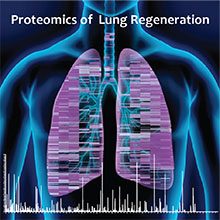How the lung repairs its wounds

Source: Fotolia [M] Herbert Schiller
According to the World Health Organization (WHO), lung diseases are the third most common cause of death worldwide: toxic particles, infections, and chronic inflammatory responses pose a permanent threat to our lungs.
To date, the regenerative mechanisms leading to healing of lung injury remain incompletely understood. Since few to no causal therapies are in place for most lung diseases, it is important to understand how these healing processes, which involve initial inflammation, fibrosis, and then resolution thereof, occur in the lung.
Using novel mass spectrometry techniques, an interdisciplinary team of scientists led by Prof. Matthias Mann, Director at the MPI of Biochemistry, and Prof. Oliver Eickelberg, Chairman of the Comprehensive Pneumology Center (CPC) at the Helmholtz Zentrum München and University Hospital of the Ludwig-Maximilians-Universität, has now succeeded, for the first time, to quantify and profile dynamic changes in the composition of the lung tissue throughout the different phases of lung regeneration.
More than 8,000 proteins examined
When the pulmonary alveoli are damaged, various proteins are secreted into the extracellular space, where they form the so-called extracellular matrix (ECM). These proteins are crucial for tissue healing by instructing various processes, including the activation of specific stem cell populations, ensuring that lung tissue can be restored to its original condition.
Now, the scientists succeeded for the first time in identifying and quantifying the abundance and solubility of more than 8,000 proteins in the lung proteome throughout the multistage tissue repair processes. “The information we have gained about the dynamic changes in ECM composition and its interactions with various secreted growth factor proteins enables us to develop new hypotheses for the activation of stem cells in the lung,” explains Dr. Herbert Schiller, first author of the study.
The findings of the research team will provide an important basis for further translational research on the development of pulmonary fibrosis* and chronic lung diseases in general, the scientists say. “These novel mass spectrometry techniques enable us to analyze variations in the type and abundance of proteins in patients with lung fibrosis and healthy individuals and will therefore likely lead to new approaches for the treatment of chronic lung diseases in general and lung fibrosis in particular”, Eickelberg predicts.
Further information
Background:
* Pulmonary fibrosis is a chronic lung disease, characterized by pathological accumulation of ECM proteins, which results in hardening of the lung and thus difficulties to breathe. The development of fibrosis is believed to be a result of defective regeneration mechanisms.
Original publication:
Schiller, HB et al. (2015) Time- and compartment-resolved proteome profiling of the extracellular niche in lung injury and repair, Molecular Systems Biology, DOI: : 10.15252/msb.20156123
As German Research Center for Environmental Health, Helmholtz Zentrum München pursues the goal of developing personalized medical approaches for the prevention and therapy of major common diseases such as diabetes mellitus and lung diseases. To achieve this, it investigates the interaction of genetics, environmental factors and lifestyle. The Helmholtz Zentrum München has about 2,300 staff members and is headquartered in Neuherberg in the north of Munich. Helmholtz Zentrum München is a member of the Helmholtz Association, a community of 18 scientific-technical and medical-biological research centers with a total of about 37,000 staff members.
The Comprehensive Pneumology Center (CPC) is a joint research project of the Helmholtz Zentrum München, the Ludwig-Maximilians-Universität Clinic Complex and the Asklepios Fachkliniken München-Gauting. The CPC's objective is to conduct research on chronic lung diseases in order to develop new diagnosis and therapy strategies. The CPC maintains a focus on experimental pneumology with the investigation of cellular, molecular and immunological mechanisms involved in lung diseases. The CPC is a site of the Deutsches Zentrum für Lungenforschung (DZL).
Contact for the media:
Department of Communication, Helmholtz Zentrum München – German Research Center for Environmental Health (GmbH), Ingolstädter Landstr. 1, 85764 Neuherberg – Phone: +49 89 3187 2238 – Fax: +49 89 3187 3324 – E-mail: presse@helmholtz-muenchen.de
Scientific contact at Helmholtz Zentrum München:
Prof. Dr. Oliver Eickelberg, Helmholtz Zentrum München – Deutsches Forschungszentrum für Gesundheit und Umwelt (GmbH), Institut für Lungenbiologie, Ingolstädter Landstr. 1, 85764 Neuherberg – Phone: +49 89 3187 4666 – E-mail: oliver.eickelberg@helmholtz-muenchen.de
http://msb.embopress.org/cgi/doi/10.15252/msb.20156123 – Link to the publication
http://www.helmholtz-muenchen.de/en/news/press-releases/2015/index.html – Press Releases of the Helmholtz Zentrum München
http://www.helmholtz-muenchen.de/en/ilbd/index.html – Institut für Lungenbiologie/Comprehensive Pneumology Center
Media Contact
All latest news from the category: Life Sciences and Chemistry
Articles and reports from the Life Sciences and chemistry area deal with applied and basic research into modern biology, chemistry and human medicine.
Valuable information can be found on a range of life sciences fields including bacteriology, biochemistry, bionics, bioinformatics, biophysics, biotechnology, genetics, geobotany, human biology, marine biology, microbiology, molecular biology, cellular biology, zoology, bioinorganic chemistry, microchemistry and environmental chemistry.
Newest articles

Properties of new materials for microchips
… can now be measured well. Reseachers of Delft University of Technology demonstrated measuring performance properties of ultrathin silicon membranes. Making ever smaller and more powerful chips requires new ultrathin…

Floating solar’s potential
… to support sustainable development by addressing climate, water, and energy goals holistically. A new study published this week in Nature Energy raises the potential for floating solar photovoltaics (FPV)…

Skyrmions move at record speeds
… a step towards the computing of the future. An international research team led by scientists from the CNRS1 has discovered that the magnetic nanobubbles2 known as skyrmions can be…





















